Detailed Report: Investigating Whistleblowing Claim of Accounting
VerifiedAdded on 2023/06/04
|8
|1650
|227
Report
AI Summary
This report delves into a whistleblowing claim concerning accounting irregularities at Success Factors, a U.S. multinational company later acquired by SAP. The company faced challenges in achieving profitability and was investigated by the SEC for its non-GAAP financial reporting practices, specifically regarding backlog figures. A whistleblower alleged that salespeople manipulated contracts for commissions due to weak internal controls. The report discusses the use and limitations of non-GAAP measures, emphasizing the importance of aligning them with GAAP principles. It concludes with recommendations for preventing improper accounting, including establishing robust internal controls, periodic contract reviews, random sampling, and employee training to foster ethical conduct. Desklib provides access to similar solved assignments and past papers for students.
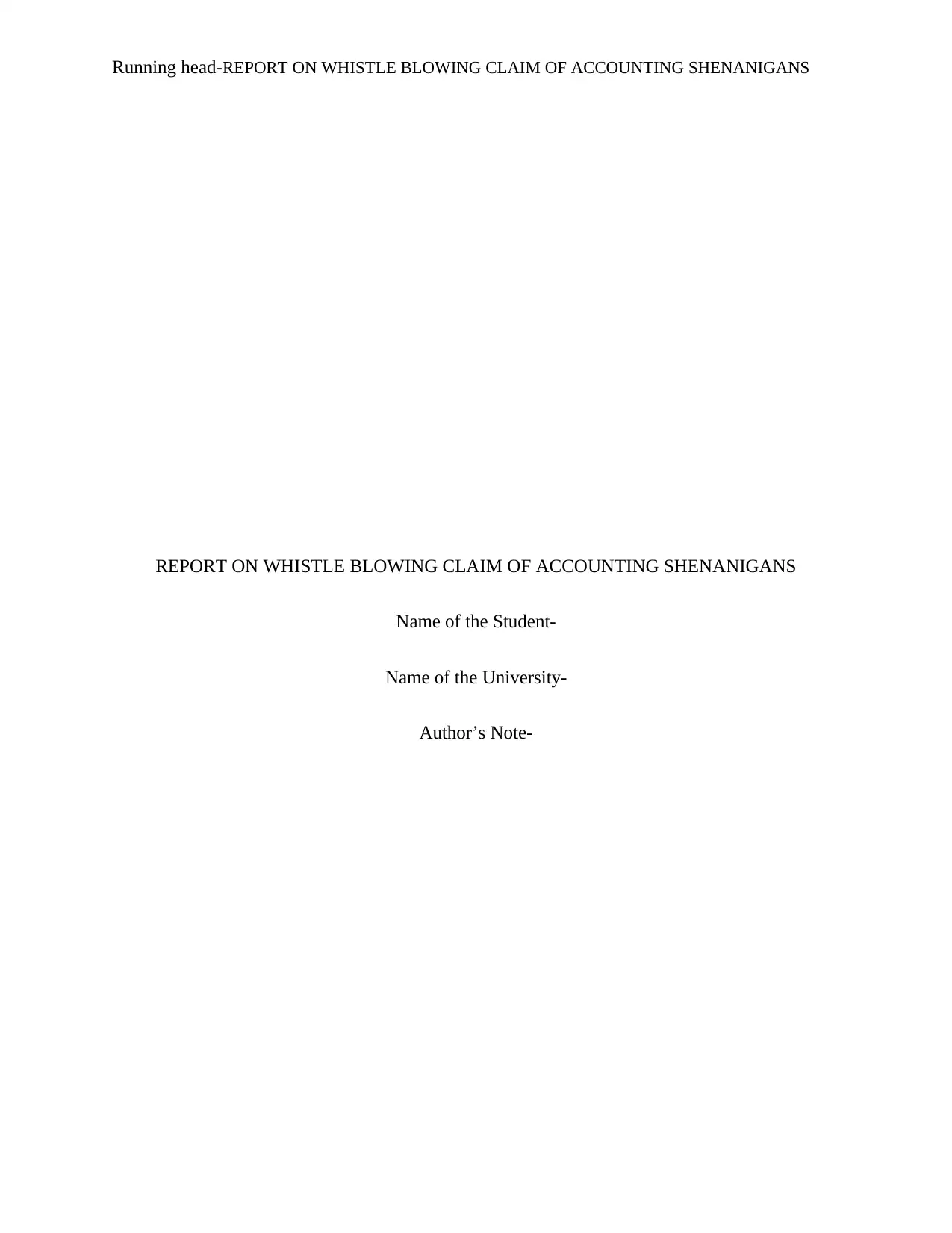
Running head-REPORT ON WHISTLE BLOWING CLAIM OF ACCOUNTING SHENANIGANS
REPORT ON WHISTLE BLOWING CLAIM OF ACCOUNTING SHENANIGANS
Name of the Student-
Name of the University-
Author’s Note-
REPORT ON WHISTLE BLOWING CLAIM OF ACCOUNTING SHENANIGANS
Name of the Student-
Name of the University-
Author’s Note-
Paraphrase This Document
Need a fresh take? Get an instant paraphrase of this document with our AI Paraphraser
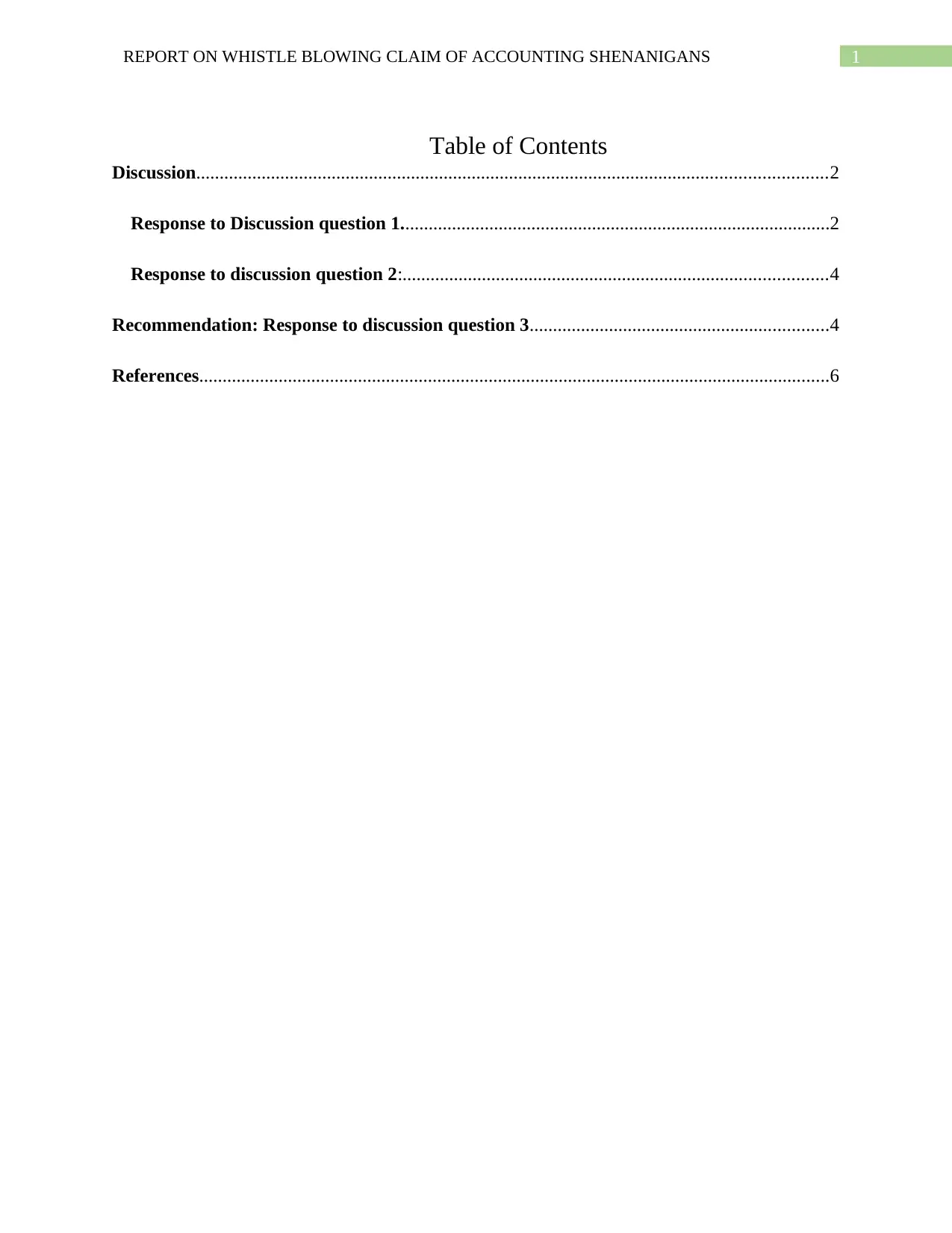
1REPORT ON WHISTLE BLOWING CLAIM OF ACCOUNTING SHENANIGANS
Table of Contents
Discussion.......................................................................................................................................2
Response to Discussion question 1............................................................................................2
Response to discussion question 2:...........................................................................................4
Recommendation: Response to discussion question 3................................................................4
References.......................................................................................................................................6
Table of Contents
Discussion.......................................................................................................................................2
Response to Discussion question 1............................................................................................2
Response to discussion question 2:...........................................................................................4
Recommendation: Response to discussion question 3................................................................4
References.......................................................................................................................................6
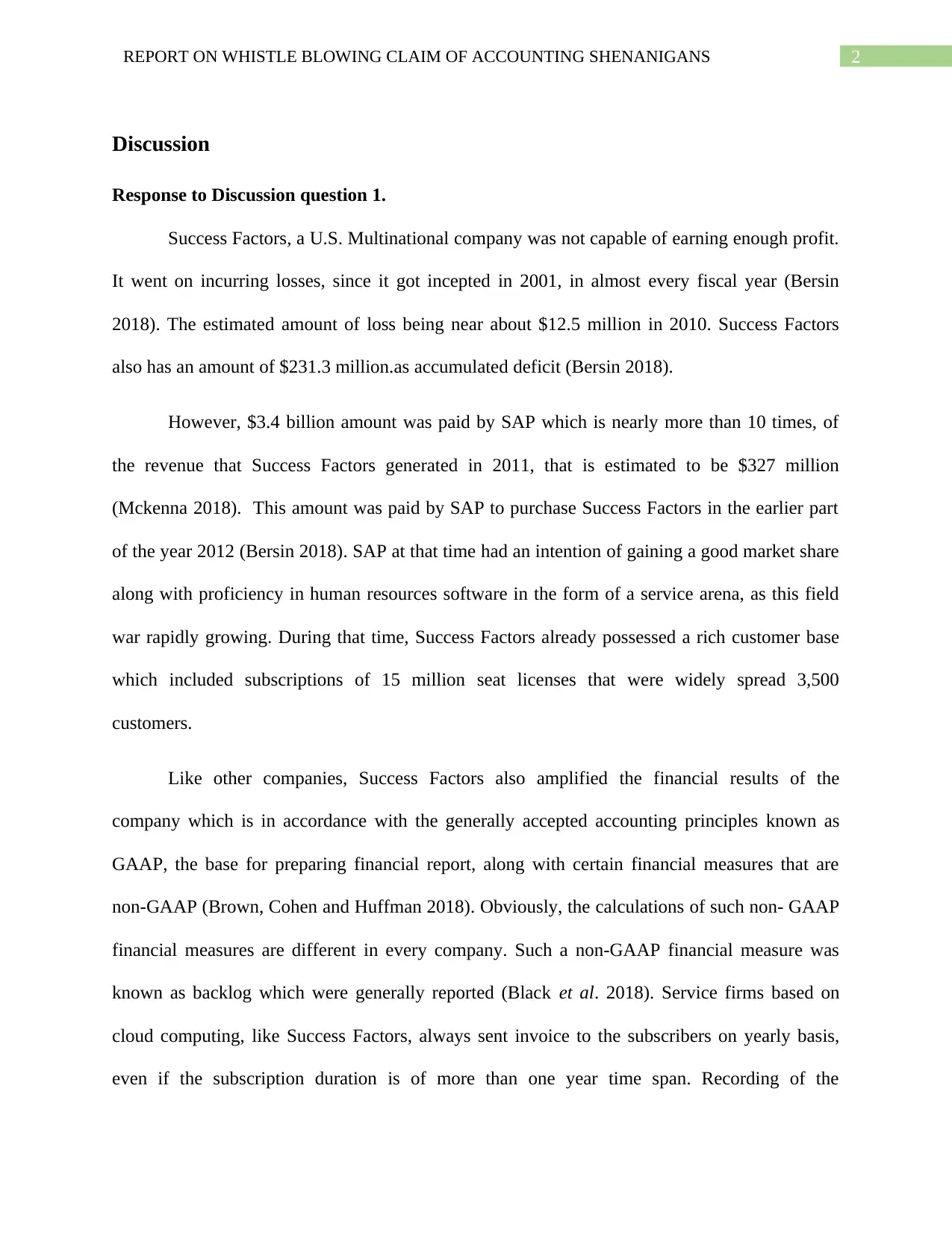
2REPORT ON WHISTLE BLOWING CLAIM OF ACCOUNTING SHENANIGANS
Discussion
Response to Discussion question 1.
Success Factors, a U.S. Multinational company was not capable of earning enough profit.
It went on incurring losses, since it got incepted in 2001, in almost every fiscal year (Bersin
2018). The estimated amount of loss being near about $12.5 million in 2010. Success Factors
also has an amount of $231.3 million.as accumulated deficit (Bersin 2018).
However, $3.4 billion amount was paid by SAP which is nearly more than 10 times, of
the revenue that Success Factors generated in 2011, that is estimated to be $327 million
(Mckenna 2018). This amount was paid by SAP to purchase Success Factors in the earlier part
of the year 2012 (Bersin 2018). SAP at that time had an intention of gaining a good market share
along with proficiency in human resources software in the form of a service arena, as this field
war rapidly growing. During that time, Success Factors already possessed a rich customer base
which included subscriptions of 15 million seat licenses that were widely spread 3,500
customers.
Like other companies, Success Factors also amplified the financial results of the
company which is in accordance with the generally accepted accounting principles known as
GAAP, the base for preparing financial report, along with certain financial measures that are
non-GAAP (Brown, Cohen and Huffman 2018). Obviously, the calculations of such non- GAAP
financial measures are different in every company. Such a non-GAAP financial measure was
known as backlog which were generally reported (Black et al. 2018). Service firms based on
cloud computing, like Success Factors, always sent invoice to the subscribers on yearly basis,
even if the subscription duration is of more than one year time span. Recording of the
Discussion
Response to Discussion question 1.
Success Factors, a U.S. Multinational company was not capable of earning enough profit.
It went on incurring losses, since it got incepted in 2001, in almost every fiscal year (Bersin
2018). The estimated amount of loss being near about $12.5 million in 2010. Success Factors
also has an amount of $231.3 million.as accumulated deficit (Bersin 2018).
However, $3.4 billion amount was paid by SAP which is nearly more than 10 times, of
the revenue that Success Factors generated in 2011, that is estimated to be $327 million
(Mckenna 2018). This amount was paid by SAP to purchase Success Factors in the earlier part
of the year 2012 (Bersin 2018). SAP at that time had an intention of gaining a good market share
along with proficiency in human resources software in the form of a service arena, as this field
war rapidly growing. During that time, Success Factors already possessed a rich customer base
which included subscriptions of 15 million seat licenses that were widely spread 3,500
customers.
Like other companies, Success Factors also amplified the financial results of the
company which is in accordance with the generally accepted accounting principles known as
GAAP, the base for preparing financial report, along with certain financial measures that are
non-GAAP (Brown, Cohen and Huffman 2018). Obviously, the calculations of such non- GAAP
financial measures are different in every company. Such a non-GAAP financial measure was
known as backlog which were generally reported (Black et al. 2018). Service firms based on
cloud computing, like Success Factors, always sent invoice to the subscribers on yearly basis,
even if the subscription duration is of more than one year time span. Recording of the
⊘ This is a preview!⊘
Do you want full access?
Subscribe today to unlock all pages.

Trusted by 1+ million students worldwide
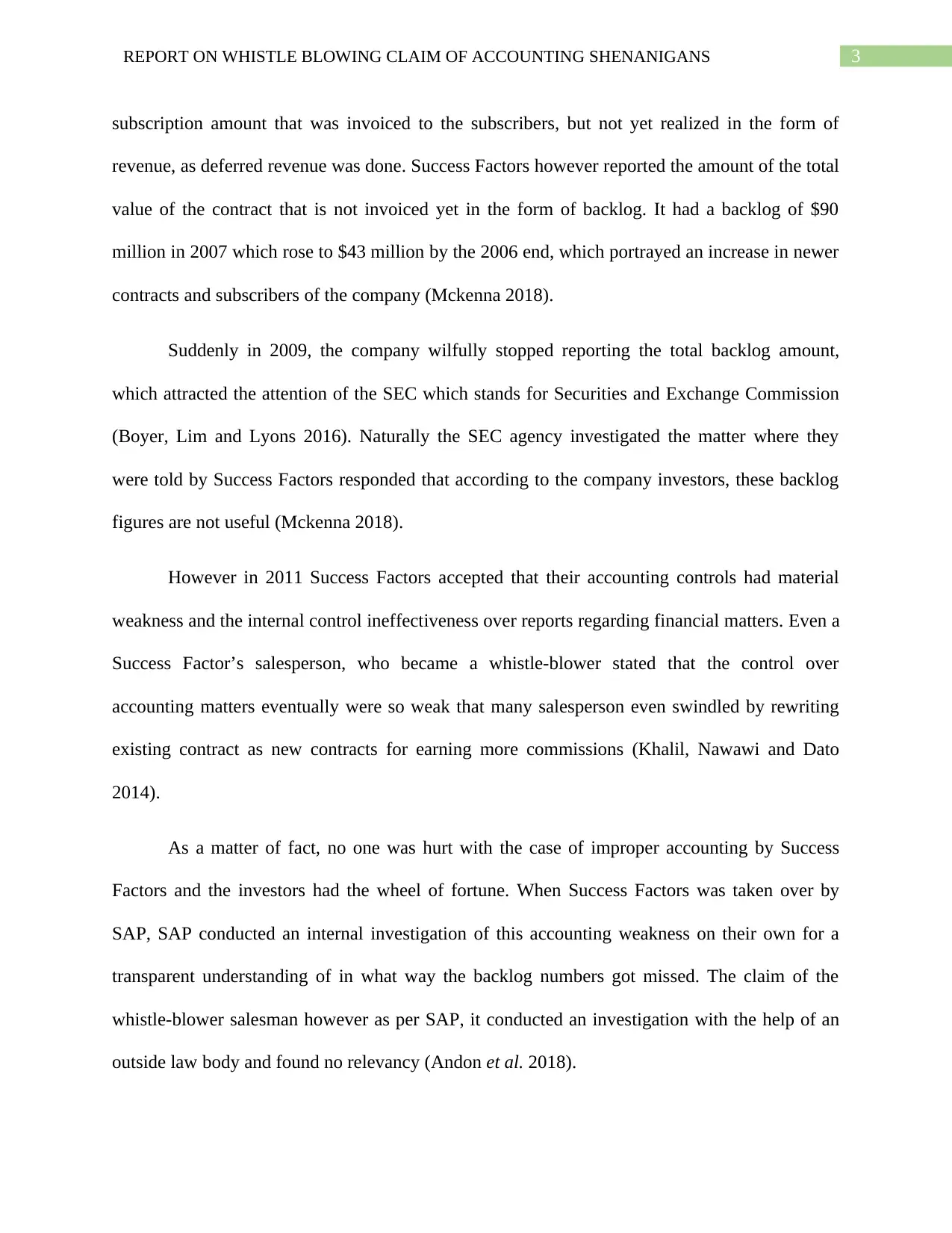
3REPORT ON WHISTLE BLOWING CLAIM OF ACCOUNTING SHENANIGANS
subscription amount that was invoiced to the subscribers, but not yet realized in the form of
revenue, as deferred revenue was done. Success Factors however reported the amount of the total
value of the contract that is not invoiced yet in the form of backlog. It had a backlog of $90
million in 2007 which rose to $43 million by the 2006 end, which portrayed an increase in newer
contracts and subscribers of the company (Mckenna 2018).
Suddenly in 2009, the company wilfully stopped reporting the total backlog amount,
which attracted the attention of the SEC which stands for Securities and Exchange Commission
(Boyer, Lim and Lyons 2016). Naturally the SEC agency investigated the matter where they
were told by Success Factors responded that according to the company investors, these backlog
figures are not useful (Mckenna 2018).
However in 2011 Success Factors accepted that their accounting controls had material
weakness and the internal control ineffectiveness over reports regarding financial matters. Even a
Success Factor’s salesperson, who became a whistle-blower stated that the control over
accounting matters eventually were so weak that many salesperson even swindled by rewriting
existing contract as new contracts for earning more commissions (Khalil, Nawawi and Dato
2014).
As a matter of fact, no one was hurt with the case of improper accounting by Success
Factors and the investors had the wheel of fortune. When Success Factors was taken over by
SAP, SAP conducted an internal investigation of this accounting weakness on their own for a
transparent understanding of in what way the backlog numbers got missed. The claim of the
whistle-blower salesman however as per SAP, it conducted an investigation with the help of an
outside law body and found no relevancy (Andon et al. 2018).
subscription amount that was invoiced to the subscribers, but not yet realized in the form of
revenue, as deferred revenue was done. Success Factors however reported the amount of the total
value of the contract that is not invoiced yet in the form of backlog. It had a backlog of $90
million in 2007 which rose to $43 million by the 2006 end, which portrayed an increase in newer
contracts and subscribers of the company (Mckenna 2018).
Suddenly in 2009, the company wilfully stopped reporting the total backlog amount,
which attracted the attention of the SEC which stands for Securities and Exchange Commission
(Boyer, Lim and Lyons 2016). Naturally the SEC agency investigated the matter where they
were told by Success Factors responded that according to the company investors, these backlog
figures are not useful (Mckenna 2018).
However in 2011 Success Factors accepted that their accounting controls had material
weakness and the internal control ineffectiveness over reports regarding financial matters. Even a
Success Factor’s salesperson, who became a whistle-blower stated that the control over
accounting matters eventually were so weak that many salesperson even swindled by rewriting
existing contract as new contracts for earning more commissions (Khalil, Nawawi and Dato
2014).
As a matter of fact, no one was hurt with the case of improper accounting by Success
Factors and the investors had the wheel of fortune. When Success Factors was taken over by
SAP, SAP conducted an internal investigation of this accounting weakness on their own for a
transparent understanding of in what way the backlog numbers got missed. The claim of the
whistle-blower salesman however as per SAP, it conducted an investigation with the help of an
outside law body and found no relevancy (Andon et al. 2018).
Paraphrase This Document
Need a fresh take? Get an instant paraphrase of this document with our AI Paraphraser
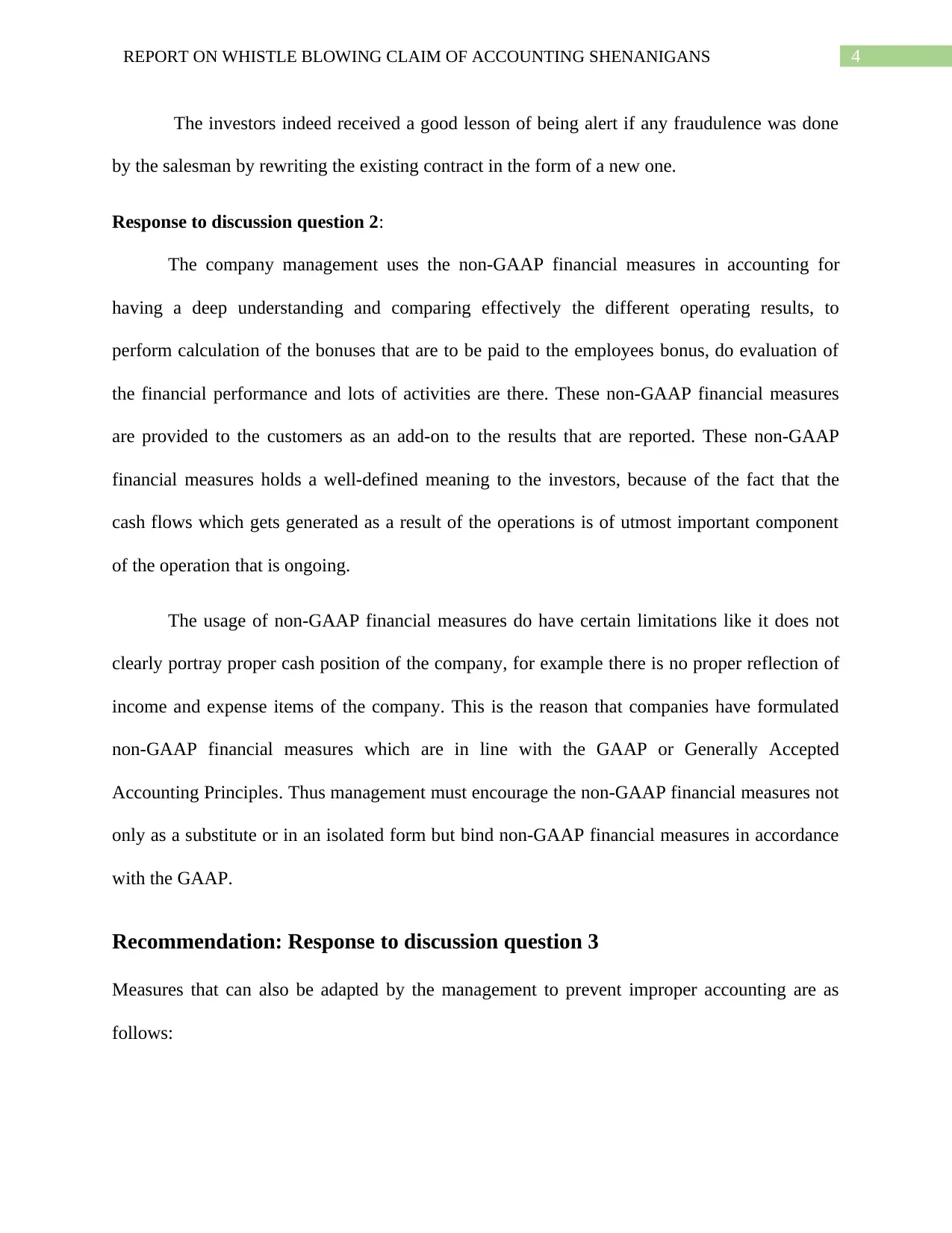
4REPORT ON WHISTLE BLOWING CLAIM OF ACCOUNTING SHENANIGANS
The investors indeed received a good lesson of being alert if any fraudulence was done
by the salesman by rewriting the existing contract in the form of a new one.
Response to discussion question 2:
The company management uses the non-GAAP financial measures in accounting for
having a deep understanding and comparing effectively the different operating results, to
perform calculation of the bonuses that are to be paid to the employees bonus, do evaluation of
the financial performance and lots of activities are there. These non-GAAP financial measures
are provided to the customers as an add-on to the results that are reported. These non-GAAP
financial measures holds a well-defined meaning to the investors, because of the fact that the
cash flows which gets generated as a result of the operations is of utmost important component
of the operation that is ongoing.
The usage of non-GAAP financial measures do have certain limitations like it does not
clearly portray proper cash position of the company, for example there is no proper reflection of
income and expense items of the company. This is the reason that companies have formulated
non-GAAP financial measures which are in line with the GAAP or Generally Accepted
Accounting Principles. Thus management must encourage the non-GAAP financial measures not
only as a substitute or in an isolated form but bind non-GAAP financial measures in accordance
with the GAAP.
Recommendation: Response to discussion question 3
Measures that can also be adapted by the management to prevent improper accounting are as
follows:
The investors indeed received a good lesson of being alert if any fraudulence was done
by the salesman by rewriting the existing contract in the form of a new one.
Response to discussion question 2:
The company management uses the non-GAAP financial measures in accounting for
having a deep understanding and comparing effectively the different operating results, to
perform calculation of the bonuses that are to be paid to the employees bonus, do evaluation of
the financial performance and lots of activities are there. These non-GAAP financial measures
are provided to the customers as an add-on to the results that are reported. These non-GAAP
financial measures holds a well-defined meaning to the investors, because of the fact that the
cash flows which gets generated as a result of the operations is of utmost important component
of the operation that is ongoing.
The usage of non-GAAP financial measures do have certain limitations like it does not
clearly portray proper cash position of the company, for example there is no proper reflection of
income and expense items of the company. This is the reason that companies have formulated
non-GAAP financial measures which are in line with the GAAP or Generally Accepted
Accounting Principles. Thus management must encourage the non-GAAP financial measures not
only as a substitute or in an isolated form but bind non-GAAP financial measures in accordance
with the GAAP.
Recommendation: Response to discussion question 3
Measures that can also be adapted by the management to prevent improper accounting are as
follows:
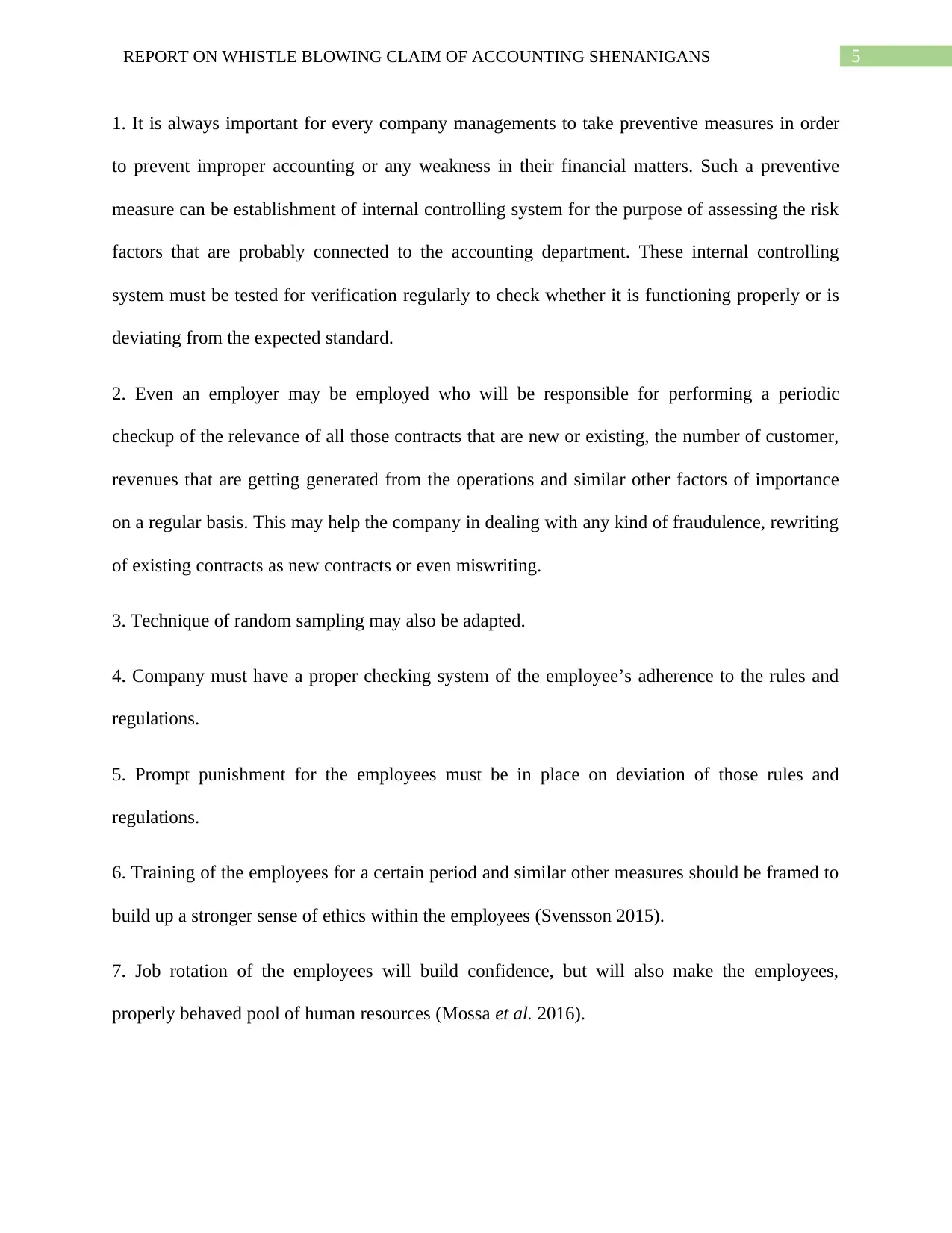
5REPORT ON WHISTLE BLOWING CLAIM OF ACCOUNTING SHENANIGANS
1. It is always important for every company managements to take preventive measures in order
to prevent improper accounting or any weakness in their financial matters. Such a preventive
measure can be establishment of internal controlling system for the purpose of assessing the risk
factors that are probably connected to the accounting department. These internal controlling
system must be tested for verification regularly to check whether it is functioning properly or is
deviating from the expected standard.
2. Even an employer may be employed who will be responsible for performing a periodic
checkup of the relevance of all those contracts that are new or existing, the number of customer,
revenues that are getting generated from the operations and similar other factors of importance
on a regular basis. This may help the company in dealing with any kind of fraudulence, rewriting
of existing contracts as new contracts or even miswriting.
3. Technique of random sampling may also be adapted.
4. Company must have a proper checking system of the employee’s adherence to the rules and
regulations.
5. Prompt punishment for the employees must be in place on deviation of those rules and
regulations.
6. Training of the employees for a certain period and similar other measures should be framed to
build up a stronger sense of ethics within the employees (Svensson 2015).
7. Job rotation of the employees will build confidence, but will also make the employees,
properly behaved pool of human resources (Mossa et al. 2016).
1. It is always important for every company managements to take preventive measures in order
to prevent improper accounting or any weakness in their financial matters. Such a preventive
measure can be establishment of internal controlling system for the purpose of assessing the risk
factors that are probably connected to the accounting department. These internal controlling
system must be tested for verification regularly to check whether it is functioning properly or is
deviating from the expected standard.
2. Even an employer may be employed who will be responsible for performing a periodic
checkup of the relevance of all those contracts that are new or existing, the number of customer,
revenues that are getting generated from the operations and similar other factors of importance
on a regular basis. This may help the company in dealing with any kind of fraudulence, rewriting
of existing contracts as new contracts or even miswriting.
3. Technique of random sampling may also be adapted.
4. Company must have a proper checking system of the employee’s adherence to the rules and
regulations.
5. Prompt punishment for the employees must be in place on deviation of those rules and
regulations.
6. Training of the employees for a certain period and similar other measures should be framed to
build up a stronger sense of ethics within the employees (Svensson 2015).
7. Job rotation of the employees will build confidence, but will also make the employees,
properly behaved pool of human resources (Mossa et al. 2016).
⊘ This is a preview!⊘
Do you want full access?
Subscribe today to unlock all pages.

Trusted by 1+ million students worldwide
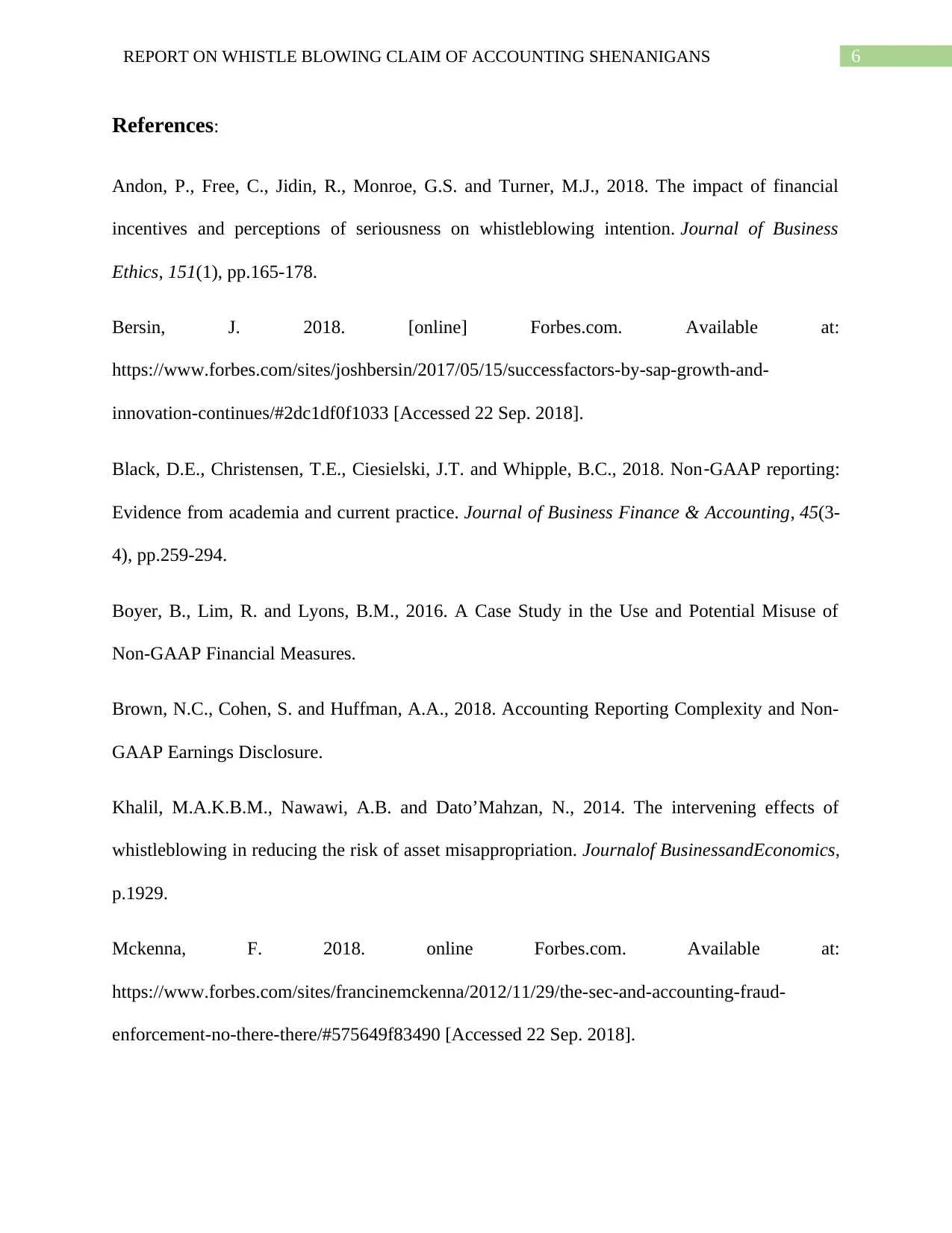
6REPORT ON WHISTLE BLOWING CLAIM OF ACCOUNTING SHENANIGANS
References:
Andon, P., Free, C., Jidin, R., Monroe, G.S. and Turner, M.J., 2018. The impact of financial
incentives and perceptions of seriousness on whistleblowing intention. Journal of Business
Ethics, 151(1), pp.165-178.
Bersin, J. 2018. [online] Forbes.com. Available at:
https://www.forbes.com/sites/joshbersin/2017/05/15/successfactors-by-sap-growth-and-
innovation-continues/#2dc1df0f1033 [Accessed 22 Sep. 2018].
Black, D.E., Christensen, T.E., Ciesielski, J.T. and Whipple, B.C., 2018. Non‐GAAP reporting:
Evidence from academia and current practice. Journal of Business Finance & Accounting, 45(3-
4), pp.259-294.
Boyer, B., Lim, R. and Lyons, B.M., 2016. A Case Study in the Use and Potential Misuse of
Non-GAAP Financial Measures.
Brown, N.C., Cohen, S. and Huffman, A.A., 2018. Accounting Reporting Complexity and Non-
GAAP Earnings Disclosure.
Khalil, M.A.K.B.M., Nawawi, A.B. and Dato’Mahzan, N., 2014. The intervening effects of
whistleblowing in reducing the risk of asset misappropriation. Journalof BusinessandEconomics,
p.1929.
Mckenna, F. 2018. online Forbes.com. Available at:
https://www.forbes.com/sites/francinemckenna/2012/11/29/the-sec-and-accounting-fraud-
enforcement-no-there-there/#575649f83490 [Accessed 22 Sep. 2018].
References:
Andon, P., Free, C., Jidin, R., Monroe, G.S. and Turner, M.J., 2018. The impact of financial
incentives and perceptions of seriousness on whistleblowing intention. Journal of Business
Ethics, 151(1), pp.165-178.
Bersin, J. 2018. [online] Forbes.com. Available at:
https://www.forbes.com/sites/joshbersin/2017/05/15/successfactors-by-sap-growth-and-
innovation-continues/#2dc1df0f1033 [Accessed 22 Sep. 2018].
Black, D.E., Christensen, T.E., Ciesielski, J.T. and Whipple, B.C., 2018. Non‐GAAP reporting:
Evidence from academia and current practice. Journal of Business Finance & Accounting, 45(3-
4), pp.259-294.
Boyer, B., Lim, R. and Lyons, B.M., 2016. A Case Study in the Use and Potential Misuse of
Non-GAAP Financial Measures.
Brown, N.C., Cohen, S. and Huffman, A.A., 2018. Accounting Reporting Complexity and Non-
GAAP Earnings Disclosure.
Khalil, M.A.K.B.M., Nawawi, A.B. and Dato’Mahzan, N., 2014. The intervening effects of
whistleblowing in reducing the risk of asset misappropriation. Journalof BusinessandEconomics,
p.1929.
Mckenna, F. 2018. online Forbes.com. Available at:
https://www.forbes.com/sites/francinemckenna/2012/11/29/the-sec-and-accounting-fraud-
enforcement-no-there-there/#575649f83490 [Accessed 22 Sep. 2018].
Paraphrase This Document
Need a fresh take? Get an instant paraphrase of this document with our AI Paraphraser
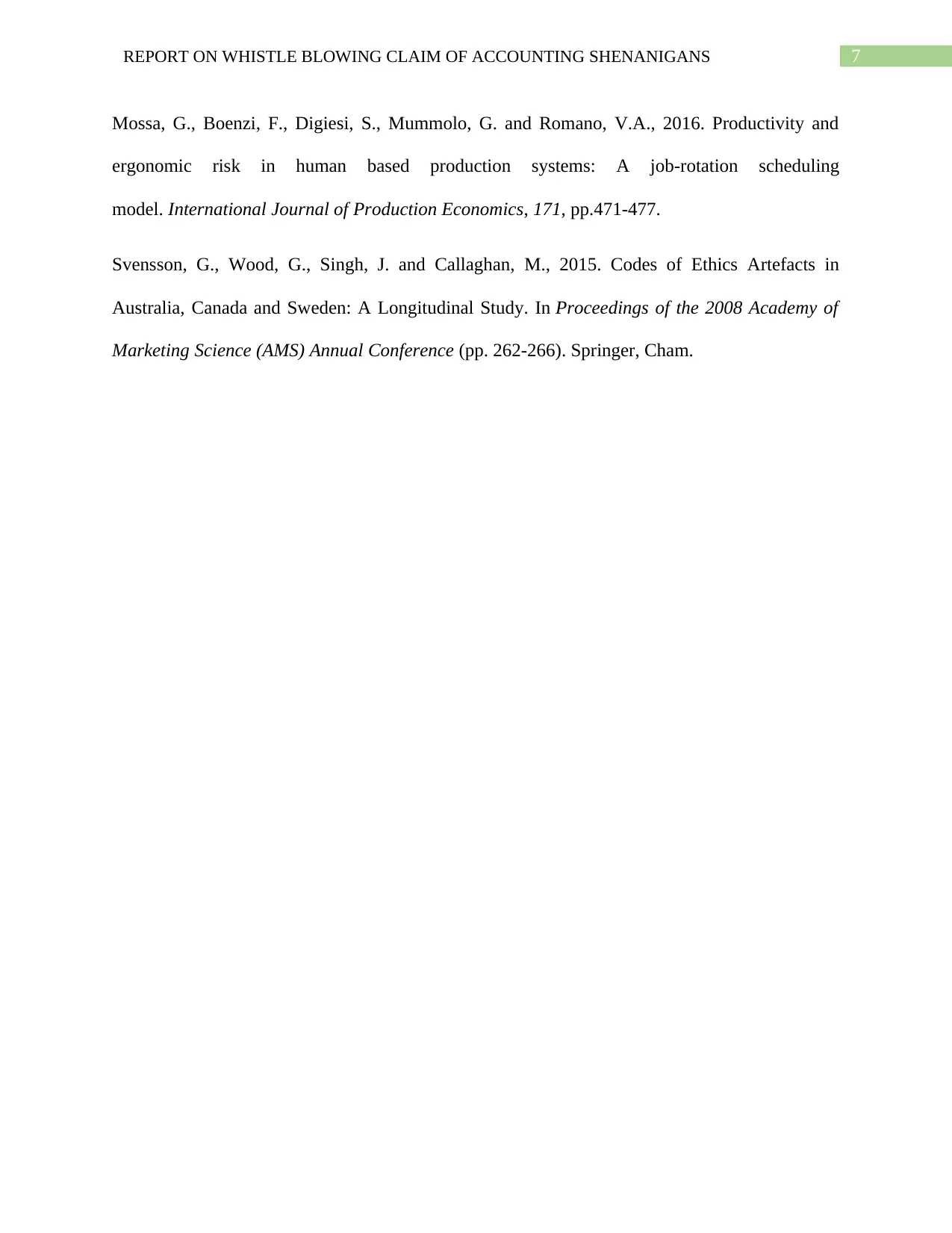
7REPORT ON WHISTLE BLOWING CLAIM OF ACCOUNTING SHENANIGANS
Mossa, G., Boenzi, F., Digiesi, S., Mummolo, G. and Romano, V.A., 2016. Productivity and
ergonomic risk in human based production systems: A job-rotation scheduling
model. International Journal of Production Economics, 171, pp.471-477.
Svensson, G., Wood, G., Singh, J. and Callaghan, M., 2015. Codes of Ethics Artefacts in
Australia, Canada and Sweden: A Longitudinal Study. In Proceedings of the 2008 Academy of
Marketing Science (AMS) Annual Conference (pp. 262-266). Springer, Cham.
Mossa, G., Boenzi, F., Digiesi, S., Mummolo, G. and Romano, V.A., 2016. Productivity and
ergonomic risk in human based production systems: A job-rotation scheduling
model. International Journal of Production Economics, 171, pp.471-477.
Svensson, G., Wood, G., Singh, J. and Callaghan, M., 2015. Codes of Ethics Artefacts in
Australia, Canada and Sweden: A Longitudinal Study. In Proceedings of the 2008 Academy of
Marketing Science (AMS) Annual Conference (pp. 262-266). Springer, Cham.
1 out of 8
Your All-in-One AI-Powered Toolkit for Academic Success.
+13062052269
info@desklib.com
Available 24*7 on WhatsApp / Email
![[object Object]](/_next/static/media/star-bottom.7253800d.svg)
Unlock your academic potential
Copyright © 2020–2025 A2Z Services. All Rights Reserved. Developed and managed by ZUCOL.


